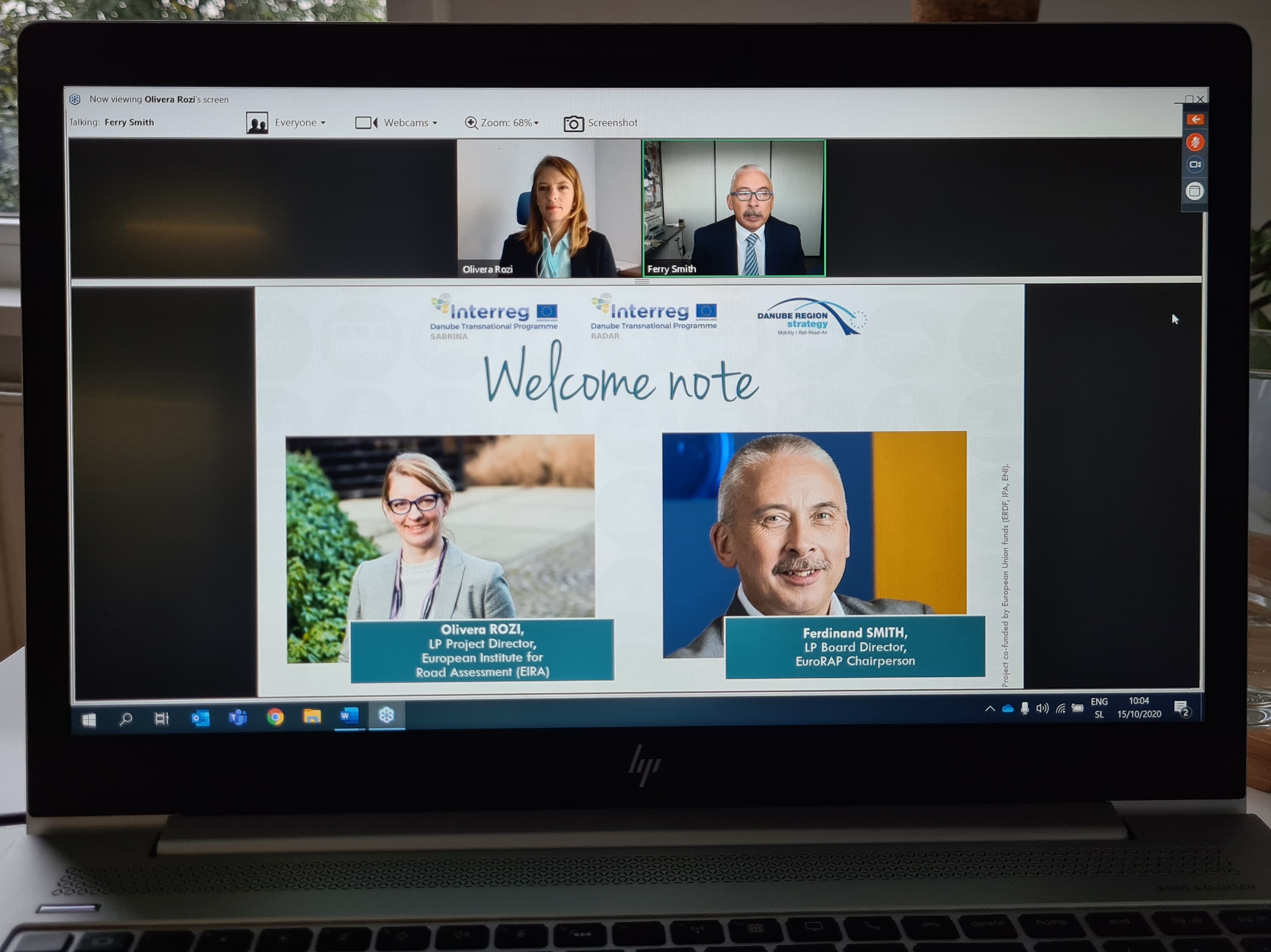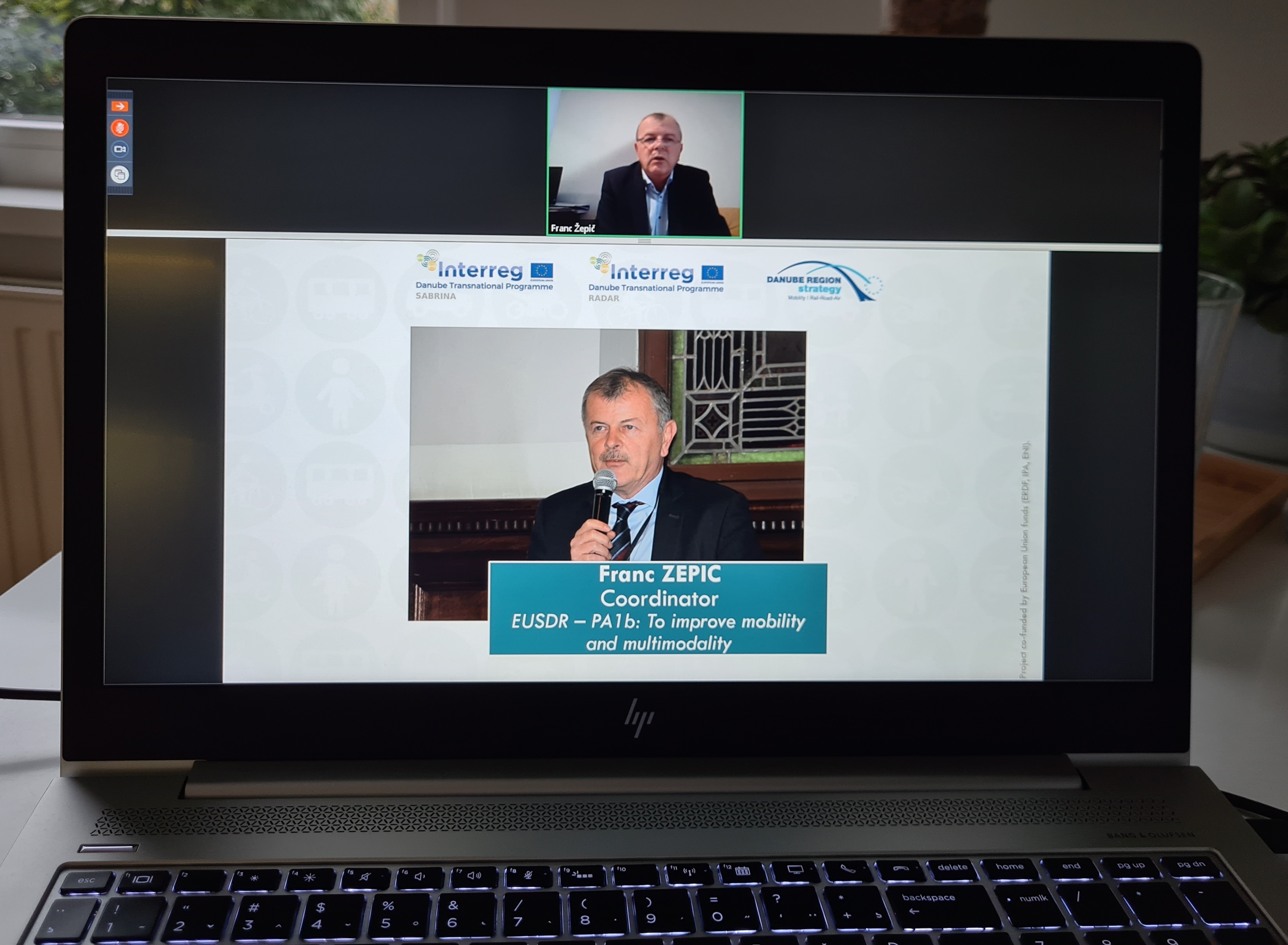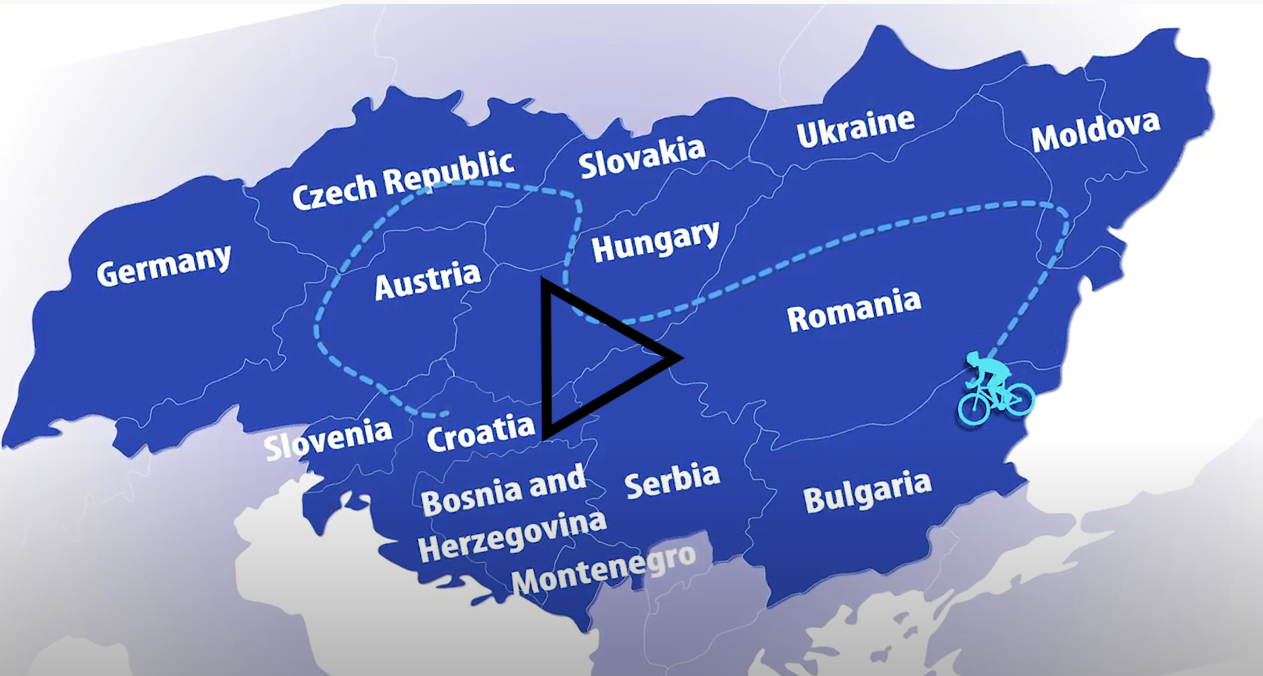SABRINA - SABRINA project’s innovative approach to bicycle infrastructure safety and RADAR project showcase of results inspired 160 participants at the joint conference
20-10-2020
“Road safety injection is a cocktail of ingredients. Do not let people tell you that road accidents just happen and that fatalities are inevitable consequences of drivers’ errors. We know and have the methods to prevent mistakes, leading to lost lives and serious injuries.”
-- Matthew Baldwin, European Commission, Department of Mobility
October 15, 2020: More than 250 road safety experts and representatives of the road infrastructure safety sector from the Danube area and transport stakeholders from more than 40 countries from all over the world registered for the joint online conference of SABRINA and RADAR projects organized in cooperation with the European Union Strategy for Danube Region (EUSDR) – PA1b: To improve mobility and multimodality – Road, Rail, and Air Links.
The conference 'Improving Road Safety in Danube Area for all Road Users: Challenges and Opportunities in the Second Decade of Action for Road Safety (2021–2030)' was an opportunity for road safety organizations and experts to discuss and chart the future strategic directions focusing on the improvement of the road infrastructure safety in the Danube area for all road users.
 “Covid-19 deviates our attention from this other pandemic and the fact that every single day worldwide more than 3.700 people lose their lives in traffic. In the first decade of action for road safety, we tried to get a grip on this, we worked out fingers to the bone, we put a lot of effort in this, but unfortunately, it was not enough. We must try harder in the next decade, we have to do more, we have to improve what we already started in the first decade of action, but also have to do a different thing.” With these words, the Chairman of the European Road Assessment Programme (EuroRAP) Ferdinand Smith opened the joint conference of projects Risk Assessment on Danube Area Roads (RADAR) and Safer Bicycle Routes in Danube Area (SABRINA).
“Covid-19 deviates our attention from this other pandemic and the fact that every single day worldwide more than 3.700 people lose their lives in traffic. In the first decade of action for road safety, we tried to get a grip on this, we worked out fingers to the bone, we put a lot of effort in this, but unfortunately, it was not enough. We must try harder in the next decade, we have to do more, we have to improve what we already started in the first decade of action, but also have to do a different thing.” With these words, the Chairman of the European Road Assessment Programme (EuroRAP) Ferdinand Smith opened the joint conference of projects Risk Assessment on Danube Area Roads (RADAR) and Safer Bicycle Routes in Danube Area (SABRINA).
What can Covid-19 teach us about road safety?
At this high-profile event, government officials, European Commission representatives, and a range of road safety advocates announced strong plans to address another health crisis that has been going on for decades. We cannot help but wonder what Covid-19 can teach us about road safety and mobility and what can be done in this field to save lives and prevent injuries in these new circumstances.
“I want to draw your attention to the extraordinary figure of 1.35 million global dead on our roads this year. In the era of Covid which is now sadly past a million deaths, we have a broadly similar number of deaths on our roads – each and every year. Just in the European Union alone, we have 23.000 dead, which accounts for about 51 per million of the population, and let’s not forget 135.000 serious injuries. In the era of Covid we have learned that the public accepts strong public action to protect public health and that is what we should take as an encouragement to tackle this annual scourge of road safety. […] We want to build back better, we don’t want to go back to the old normal,” stated Matthew Baldwin, Deputy Director-General, European Commission, Department of Mobility and Transport and European Coordinator for road safety.
He also pointed out that we had been experiencing a massive transformation in transport caused by the Covid crisis. “We’ve seen a huge increase in active mobility – walkers and cyclists – that’s exciting. A massive decline in the use of public transport, a huge drop, and then rebound in terms of car traffic. Fatalities went down a lot, within the EU we saved 1500 lives during the 3-months lockdown. But those fatality numbers did not decline as much as the decline in traffic predicted they would.”
Steve Phillips, Secretary-General, Conference of European Directors of Roads (CEDR), added the question for the post-Covid era is how we turn what was often considered as challenges into win-win situations. “We’ve heard a lot about the growth of, particularly cycling. Road authorities are bringing forward the plans for cycling infrastructure and implementing them much faster than we would have thought. That’s great and they are learning a lot of lessons as they are doing this.”
Road safety does not stop at borders
 Franc Žepič, Coordinator, European Union Strategy for Danube Region (EUSDR) – PA1b: To improve mobility and multimodality – Road, Rail, and Air Links, agreed and continued that “to keep traffic moving, to make it efficient, sustainable, safe, and secure, we need to make joint efforts. To improve road safety, we need to develop and use the right measures to enhance the safety of all road users. Our common goal should be to experience the benefits of road and bicycle networks that will enable us to move efficiently, safely, and securely between all the Danube region countries and beyond. That is why we need to pay special attention when planning infrastructure projects across borders. High standards for quality and safety should be the same in all countries, all over the world and all over Europe. We are here because the road safety does not stop at borders.”
Franc Žepič, Coordinator, European Union Strategy for Danube Region (EUSDR) – PA1b: To improve mobility and multimodality – Road, Rail, and Air Links, agreed and continued that “to keep traffic moving, to make it efficient, sustainable, safe, and secure, we need to make joint efforts. To improve road safety, we need to develop and use the right measures to enhance the safety of all road users. Our common goal should be to experience the benefits of road and bicycle networks that will enable us to move efficiently, safely, and securely between all the Danube region countries and beyond. That is why we need to pay special attention when planning infrastructure projects across borders. High standards for quality and safety should be the same in all countries, all over the world and all over Europe. We are here because the road safety does not stop at borders.”
The conference aimed at challenges and opportunities in the Second decade of Action for Road Safety (2021-2030) proclaimed by the United Nations General Assembly in August 2020. The goal in the next ten years is to reduce road traffic deaths and injuries by at least 50 %. The resolution encourages the Member States to make efforts to ensure the safety and protection for all road users through safer road infrastructure by taking into account the needs of motorized and non-motorized transport, and other vulnerable road users, especially on the highest-risk roads with high rates of crashes, through a combination of proper planning and safety assessment, including through the identification of crash-prone areas, design, building and maintenance of roads, signal systems and other infrastructure, taking into consideration the geography of the country.
Road infrastructure needs to be designed proactively and reactively
Keeping in mind the Second decade of Action for Road Safety, Lina Konstantinopoulou, Secretary-General, European Road Assessment Programme (EuroRAP), added that “the road infrastructure needs to be safe for all road users – vehicles, pedestrians, cyclists, and motorcyclists. It needs to be designed proactively and reactivity in terms of road safety, but in a common and objective manner. We need to focus on the most cost-effective actions, such as road maintenance upgrades, pedestrian footpaths, or bike lanes, and with a focus on higher risk intersections. Tackling road safety requires a holistic approach and a responsibility for the safe system approach.”
SABRINA: an innovative approach to bicycle infrastructure safety
 For the SABRINA project, this was a kick-off conference with the main goal to raise awareness about the project and present its objectives and goals. To show the conference participants why we started with the SABRINA project and what is the current status of cycling infrastructure in all project partners’ countries, we took them on a Virtual Field Visit.
For the SABRINA project, this was a kick-off conference with the main goal to raise awareness about the project and present its objectives and goals. To show the conference participants why we started with the SABRINA project and what is the current status of cycling infrastructure in all project partners’ countries, we took them on a Virtual Field Visit.
Large parts of the Danube road network rate poorly for safety, particularly for vulnerable road-users, and death rates in many countries are higher than the EU average. Cyclists are amongst the most vulnerable road users.
According to the European Commission, more than 2000 cyclists were killed on the EU roads in 2018. It is therefore crucial to improve conditions for road bicycle infrastructure safety in the Danube area by raising capacities of all relevant national, regional, and local stakeholders to build and improve bicycle infrastructure in a safe and sustainable way.
Klaus Machata from the Austrian Road Safety Board explained that “the quality of our cycling networks determines by large their safety and the attractiveness of cycling as a mode of transport which became even more important in these days of Covid and these days of climate change. This is why we have introduced also best practice collection amongst many other things in the SABRINA project.”
During the conference, we also heard: Boštjan Primc from the Municipality Ilirska Bistrica, Slovenia, who presented the municipality perspective on challenges and needs of cycling infrastructure safety. Aleksander Buczyński, European Cyclists’ Federation, and Marko Ševrović, European Institute for Road Assessment – EuroRAP, explained two existing methodologies to assess cycling infrastructure safety. And finally, Olivera Rozi from the lead partner of both projects, European Institute for Road Assessment – EuroRAP, summarized the activities of the SABRINA project and presented the goals we are planning to achieve by the end of 2022.
RADAR project’s mid-term results
The conference also outlined the RADAR (Risk Assessment on Danube Area Roads) project’s mid-term results and uncovered the Road Infrastructure Safety Improvement Strategy plans. Now more than ever is important to understand the efficient and effective transport system, as well as the fast and overall safe movement of people and goods.
RADAR project is doing just that. It has a safe system approach at its heart. As Marko Ševrović, European Institute for Road Assessment – EuroRAP, stated, “in RADAR project training courses, study visits, thematic area reports approved by our Road Safety Expert group, will lead us to develop a Danube Road Infrastructure Safety Improvement Strategy plans.”
The joint conference addressed project partner countries’ national public authorities and their Associated Strategic Partners. The 160 participants who attended the online conference were representatives from non-governmental organizations, universities, and national public authorities including representatives from relevant Ministries and Road Authorities from partners’ countries. The conference paved the path for the successful start of the SABRINA project and strengthen the effects RADAR is already showing with its mid-term results.
The following resources are available from the conference:
• Click HERE to access the full recording of the conference.
• Click HERE to download the full PowerPoint presentation from the conference.
• Click HERE to watch the SABRINA Virtual Field Visit tour.
• Click HERE to watch the RADAR project Road Safety Video Campaign.
• Click HERE to download the document with the Questions & Answers from the conference.
• Click HERE to see the evaluations and other statistics from the conference.



